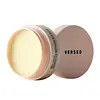What's inside
What's inside
 Key Ingredients
Key Ingredients

 Benefits
Benefits

 Concerns
Concerns

 Ingredients Side-by-side
Ingredients Side-by-side

Butyrospermum Parkii Butter
Skin ConditioningHelianthus Annuus Hybrid Oil
EmollientTricaprylin
MaskingC10-18 Triglycerides
EmollientHydroxystearic/Linolenic/Oleic Polyglycerides
EmollientPolyhydroxystearic Acid
EmulsifyingStearyl Behenate
EmollientHelianthus Annuus Seed Wax
Skin ConditioningWater
Skin ConditioningJojoba Esters
EmollientTocopheryl Acetate
AntioxidantRibes Nigrum Seed Oil
EmollientHydroxypinacolone Retinoate
Skin ConditioningTocopherol
AntioxidantLentinus Edodes Extract
Skin ConditioningGlycerin
HumectantAcacia Decurrens Flower Wax
EmollientPolyglycerin-3
HumectantSilica Silylate
EmollientDimethyl Isosorbide
SolventSodium Citrate
BufferingPhytic Acid
Potassium Sorbate
PreservativeSodium Benzoate
MaskingButyrospermum Parkii Butter, Helianthus Annuus Hybrid Oil, Tricaprylin, C10-18 Triglycerides, Hydroxystearic/Linolenic/Oleic Polyglycerides, Polyhydroxystearic Acid, Stearyl Behenate, Helianthus Annuus Seed Wax, Water, Jojoba Esters, Tocopheryl Acetate, Ribes Nigrum Seed Oil, Hydroxypinacolone Retinoate, Tocopherol, Lentinus Edodes Extract, Glycerin, Acacia Decurrens Flower Wax, Polyglycerin-3, Silica Silylate, Dimethyl Isosorbide, Sodium Citrate, Phytic Acid, Potassium Sorbate, Sodium Benzoate
Water
Skin ConditioningHelianthus Annuus Seed Oil
EmollientSorbitan Stearate
EmulsifyingCetearyl Alcohol
EmollientHydrogenated Lecithin
EmulsifyingBehenyl Alcohol
EmollientSqualane
EmollientCoconut Alkanes
EmollientHydroxypinacolone Retinoate
Skin ConditioningGanoderma Lucidum Extract
Skin ProtectingMelatonin
AntioxidantInonotus Obliquus Extract
Skin ConditioningGlycerin
HumectantRosmarinus Officinalis Leaf Extract
AntimicrobialChamomilla Recutita Flower Extract
MaskingAhnfeltiopsis Concinna Extract
Skin ConditioningCoco-Caprylate/Caprate
EmollientCetearyl Glucoside
EmulsifyingGlucose
HumectantSorbityl Laurate
EmulsifyingDimethyl Isosorbide
SolventPhenoxyethanol
PreservativeEthylhexylglycerin
Skin ConditioningWater, Helianthus Annuus Seed Oil, Sorbitan Stearate, Cetearyl Alcohol, Hydrogenated Lecithin, Behenyl Alcohol, Squalane, Coconut Alkanes, Hydroxypinacolone Retinoate, Ganoderma Lucidum Extract, Melatonin, Inonotus Obliquus Extract, Glycerin, Rosmarinus Officinalis Leaf Extract, Chamomilla Recutita Flower Extract, Ahnfeltiopsis Concinna Extract, Coco-Caprylate/Caprate, Cetearyl Glucoside, Glucose, Sorbityl Laurate, Dimethyl Isosorbide, Phenoxyethanol, Ethylhexylglycerin
 Reviews
Reviews

Alternatives
Ingredients Explained
These ingredients are found in both products.
Ingredients higher up in an ingredient list are typically present in a larger amount.
Dimethyl Isosorbide is a low-irritation solvent that helps deliver actives into your skin. It is created from glucose.
Research shows how well this ingredient works depends on the active and formulation rather than the concentration alone. This means adding more Dimethyl Isosorbide does not guarantee better penetration of ingredients into the skin.
Glycerin is already naturally found in your skin. It helps moisturize and protect your skin.
A study from 2016 found glycerin to be more effective as a humectant than AHAs and hyaluronic acid.
As a humectant, it helps the skin stay hydrated by pulling moisture to your skin. The low molecular weight of glycerin allows it to pull moisture into the deeper layers of your skin.
Hydrated skin improves your skin barrier; Your skin barrier helps protect against irritants and bacteria.
Glycerin has also been found to have antimicrobial and antiviral properties. Due to these properties, glycerin is often used in wound and burn treatments.
In cosmetics, glycerin is usually derived from plants such as soybean or palm. However, it can also be sourced from animals, such as tallow or animal fat.
This ingredient is organic, colorless, odorless, and non-toxic.
Glycerin is the name for this ingredient in American English. British English uses Glycerol/Glycerine.
Learn more about GlycerinThis ingredient is a retinoid. It usually goes by a more common name: "Granactive".
Hydroxypinacolone Retinoate (HPR) belongs to the class of retinoids that also includes retinol and tretinoin.
Retinoids have been proven to:
So what is the difference between all the retinoids?
Most retinoids need to go through a conversion line to become effective on skin. The ending product is retinoic acid. Retinoic acid is AKA tretinoin.
HPR is an ester of tretinoin. Emerging studies suggest HPR to have an added benefit that other retinoids don't have: Low irritation.
A study from 2021 found HPR to have the greatest stability when exposed to light and temperature out of all the commercial retinoids.
A note about naming:
The name "Granactive" is the trade name and the name most commonly used on packages.
Granactive is the name of the mixture - about 90% solvent and 10% HPR. A product with 5% granactive has 0.5% HPR.
Learn more about Hydroxypinacolone RetinoateWater. It's the most common cosmetic ingredient of all. You'll usually see it at the top of ingredient lists, meaning that it makes up the largest part of the product.
So why is it so popular? Water most often acts as a solvent - this means that it helps dissolve other ingredients into the formulation.
You'll also recognize water as that liquid we all need to stay alive. If you see this, drink a glass of water. Stay hydrated!
Learn more about Water